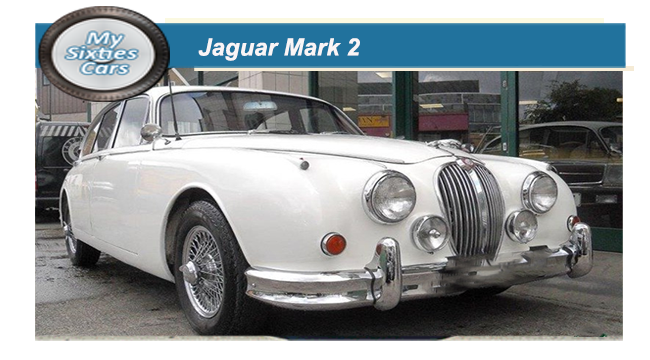
Just a few months before the Fifties drew to a close Jaguar introduced the Mk 2 version of their 2.4/3.4 saloon series, which had been in production for five years and was long overdue for a design revamp.
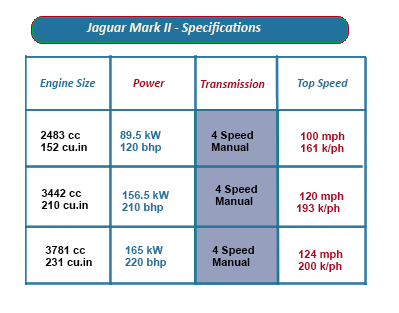 While the classic Mark II body style had been retained, with its the classical attraction of the curved roof and sloping nose emphasised by its vertical oval grille and the tapered tail it was rather dumpy in style, with thick windscreens and window surrounds.
While the classic Mark II body style had been retained, with its the classical attraction of the curved roof and sloping nose emphasised by its vertical oval grille and the tapered tail it was rather dumpy in style, with thick windscreens and window surrounds.
The Mk II version was altogether more graceful with the design team at Jaguar having made tremendous efforts in improving visibility with larger windows, a larger rear screen, and more slender roof pillars.
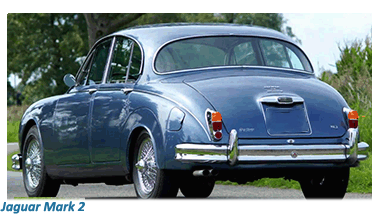 Now the Mk II was not only sleeker it could be much faster, available with a choice of three six-cylinder engines — 2.4-litre, 3.4-litre and 3.8-litre types teamed with either manual, overdrive, or automatic transmission.
Now the Mk II was not only sleeker it could be much faster, available with a choice of three six-cylinder engines — 2.4-litre, 3.4-litre and 3.8-litre types teamed with either manual, overdrive, or automatic transmission.
With Jaguar sales rising past 500 cars every week, the choice seemed endless.
The 2.4-litre engine used in the Mark II was a 2483-cc version of William Heynes's famous six-cylinder XK design, featuring twin chain-driven overhead camshafts in a light alloy cylinder head.
![]()
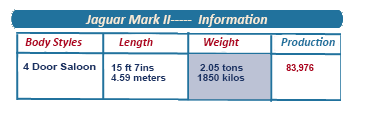
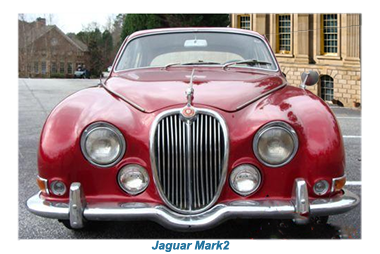 Although the 2.4 engined version had its followers, as did the 3.4 capable of generating 210 bhp, the star of the range was the new 3.8-litre version of the legendary XK engine, bored and stroked to 3781 ccs, producing 220 bhp and providing the Mark II saloon with really vivid performance.
Although the 2.4 engined version had its followers, as did the 3.4 capable of generating 210 bhp, the star of the range was the new 3.8-litre version of the legendary XK engine, bored and stroked to 3781 ccs, producing 220 bhp and providing the Mark II saloon with really vivid performance.
Mark II drivers soon discovered how quickly the 3.8 could embarrass contemporary sports cars in both acceleration and speed.
 With a slightly wider rear axle, the improved road handling was impeccable, amazingly powerful and flexible, and looked the part, especially if they were finished in a bright colour with fire engine red being the colour of choice for many, beautifully offsetting the model's chrome-plated wire-spoke wheels.
With a slightly wider rear axle, the improved road handling was impeccable, amazingly powerful and flexible, and looked the part, especially if they were finished in a bright colour with fire engine red being the colour of choice for many, beautifully offsetting the model's chrome-plated wire-spoke wheels.
In September 1966 to keep the Mark II's within a reasonable price range the 2.4-, 3.4- and 3.8-litre Mark II s were all revised, losing many accessories available as standard.
While deletions helped to reduce the cost of the car, once potential owners did their homework and added on all the features that made the Mark II so attractive, such as hide upholstery, wire wheels, and power steering, the car lost its attraction for many.
![]()
During the exciting years of the early to mid-Sixties, the Mark II catapulted Jaguar into the role of style leader for sports saloons.
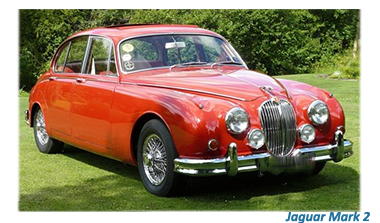 Succeeding to transcend the usual barriers of class and wealth that had prevailed in Britain during the first half of the Twentieth century: owners were and are just as likely to be wage-earners as aristocrats.
Succeeding to transcend the usual barriers of class and wealth that had prevailed in Britain during the first half of the Twentieth century: owners were and are just as likely to be wage-earners as aristocrats.
More than fifty years after it was first launched, the car's unceasing popularity among connoisseurs makes the Mark II the perfect expression of its originator's (William Lyons, Jaguar's Chairman) desire to build a vehicle of `grace, space and pace.'
The Jaguar Mark 2's winning combination of luxury and performance made it yet another icon of Sixties chic.





